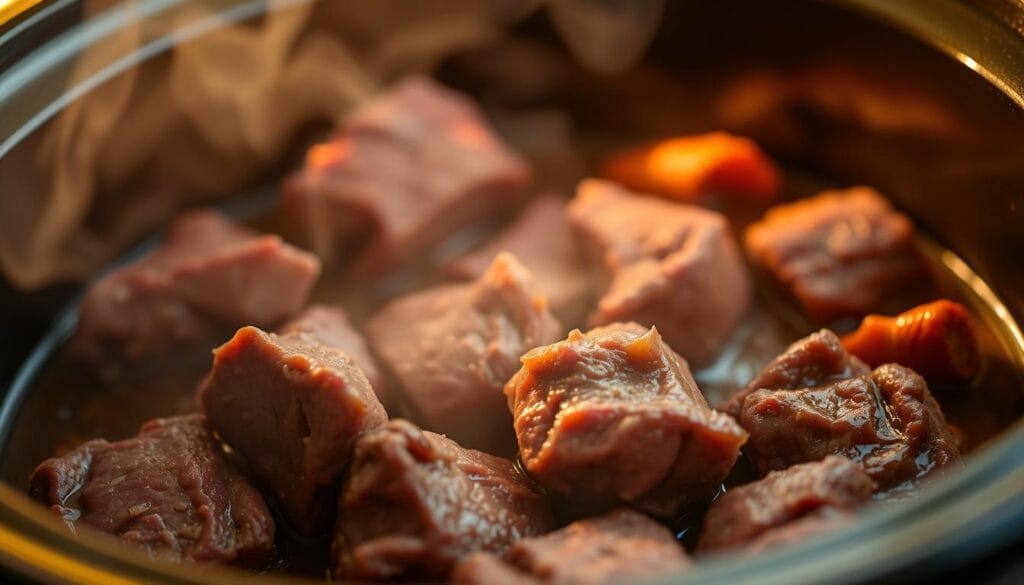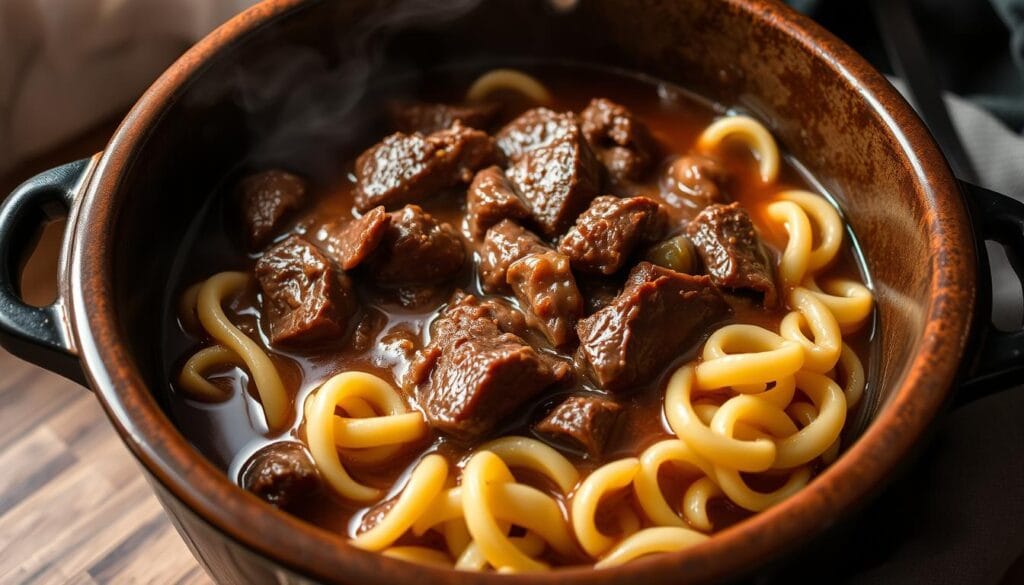Remember those evenings when you’d stumble home after a long day, craving something warm and satisfying? That’s exactly how this recipe beef tips and noodles crock pot came to life in my kitchen. Post-college life taught me one thing: good food doesn’t need to be complicated. It just needs to feel like a hug on a plate.
Imagine tender chunks of meat simmered in rich gravy, paired with soft egg noodles that soak up every drop of flavor. This dish isn’t just about filling your stomach—it’s about creating moments. Whether you’re feeding a crowd or just need leftovers for tomorrow, it’s a no-fuss solution that tastes like you’ve cooked all day.
What makes it special? The slow cooker does the heavy lifting. Toss in ingredients like onion soup mix and cream of mushroom, then let time work its magic. In 3–6 hours, you’ll have a protein-packed meal (21g per serving!) that keeps everyone satisfied. Plus, it’s versatile: swap in chicken or add herbs for a fresh twist.
Perfect for potlucks or cozy nights in, this recipe balances convenience with homemade comfort. And the best part? You’ll have more time to enjoy what matters—like that extra episode of your favorite show.
Table of Contents
Benefits of Cooking Beef Tips and Noodles in a Crock Pot
Weeknights don’t have to mean sacrificing flavor for convenience. Using a slow cooker transforms simple ingredients into meals that feel like they’ve simmered all day. The magic lies in how heat and time work together—melding tastes, tenderizing proteins, and filling your kitchen with irresistible aromas.

Why Slow Cooking Creates Tender Beef
Low, steady heat breaks down tough fibers in meat without drying it out. This method lets collagen dissolve into gelatin, resulting in melt-in-your-mouth texture. No rushed searing or constant stirring—just set it and let the appliance do its job.
Time-Saving Advantages for Busy Weeknights
Prep takes minutes. Combine ingredients in the morning, and dinner cooks itself while you tackle your day. By evening, you’ll have a hot meal ready—no last-minute scrambling. This approach reduces stress and frees up time for family or relaxation.
Flavor Development Through Slow Cooking
Onions caramelize slowly, while herbs and spices infuse into the sauce over hours. Ingredients like onion soup mix release layers of savory depth. Natural juices blend with broth, creating a rich gravy that clings to every bite. Your kitchen will smell like a cozy diner by dinnertime.
Essential Ingredients for Perfect Beef Tips and Noodles
Crafting comfort food requires more than just a recipe. Each component plays a specific role in creating that “just right” balance of textures and flavors. Let’s break down what makes this combination sing.

Selecting the Right Cut of Beef
Chuck roast works best for slow cooking. Its marbling breaks down into velvety tenderness during long simmering. Trim excess fat, but leave enough to keep the meat juicy.
The Role of Lipton Onion Soup Mix
This pantry staple delivers concentrated savory depth. It adds caramelized onion notes and helps thicken the sauce naturally. No need for extra spices—it’s a flavor shortcut that pays off.
Importance of Cream of Mushroom Soup
More than just a thickener, it brings earthy undertones. The creamy base clings to every piece of meat, creating that signature rich texture. For dietary needs, low-sodium versions work equally well.
Choosing the Best Noodles
Wide egg noodles shine here. Their ribbed surface traps gravy, while the egg content adds subtle richness. Cook them al dente separately to maintain structure. Gluten-free options like rice noodles work if you rinse them after boiling.
Want variety? Try homestyle egg noodles for extra chew or rotini pasta for tighter sauce pockets. The golden hue from egg yolks makes your dish visually inviting—a feast for eyes and appetite.
Step-by-Step Cooking Instructions
Transforming simple ingredients into a cohesive dish requires methodical steps. Let’s walk through each phase to ensure your meal comes together seamlessly, from prep to plating.

Preparing Your Meat
Start by trimming visible fat from your protein while leaving enough for moisture. Season generously with salt and pepper. For deeper flavor, lightly brown the pieces in a skillet first—though it’s optional.
Creating the Perfect Sauce Base
Combine onion soup mix, cream of mushroom, and broth in your appliance. Whisk until smooth. This mixture will thicken as it cooks, coating every piece evenly. Pro tip: Add a splash of Worcestershire sauce for extra depth.
Setting Your Appliance
Place seasoned meat into the sauce base. Cook on low for 6-8 hours or high for 3-4. The longer simmer melts connective tissues, yielding fork-tender results. Resist lifting the lid—heat escape slows cooking.
Adding Noodles at the Right Time
Boil water 30 minutes before serving. Cook egg noodles until al dente (usually 6-7 minutes). Drain and toss with butter to prevent sticking. For bolder flavor, stir noodles into the cooker during the last 15 minutes. They’ll soak up sauce without becoming mushy.
Timing matters here. If added too early, noodles absorb excess liquid and lose texture. Serve immediately after combining for ideal consistency. Leftovers? Store components separately to maintain quality.
Serving Suggestions and Pairings
Presentation transforms a meal into an experience. While your main attraction shines, thoughtful accompaniments and finishing touches create harmony on the plate. Let’s explore ways to balance textures and elevate every bite.
Complementary Side Dishes
Pair your protein-packed creation with light, crisp contrasts. A simple green salad with lemon vinaigrette cuts through richness. Roasted Brussels sprouts add caramelized depth, while steamed green beans keep things fresh.
For heartier appetites, offer crusty sourdough to mop up every drop of gravy. These choices require under 15 minutes of prep time—perfect for busy cooks.
Garnishing for Extra Flavor
Final flourishes turn comfort food into restaurant-worthy fare. Fresh herbs like chives or thyme provide vibrant color and aromatic notes. A dollop of sour cream introduces creamy tanginess that complements savory elements.
| Garnish | Effect | Prep Time |
|---|---|---|
| Toasted breadcrumbs | Adds crunch | 3 minutes |
| Fried onions | Sweet texture contrast | 5 minutes |
| Smoked paprika | Visual pop + subtle heat | Instant |
These enhancements prove that small details make big impacts. Whether hosting friends or enjoying a solo dinner, these techniques ensure your recipes always impress.
Recipe Variations and Dietary Adaptations
Your favorite comfort meal can flex to meet different needs without losing its soul-warming appeal. A few smart swaps and additions keep things exciting while accommodating dietary preferences.
Low-Carb and Gluten-Free Options
Swap traditional noodles with spiralized zucchini or shirataki varieties for grain-free alternatives. Add these during the last 30 minutes to prevent sogginess. Fresh mushrooms work better than canned—they release natural juices that deepen the sauce without added sodium.
For gluten concerns, use tamari instead of Worcestershire sauce. Thicken gravy with cornstarch instead of flour. These changes maintain richness while keeping the dish accessible to more diets.
Adding Vegetables for Extra Nutrition
Carrots and celery add sweetness and crunch when tossed in during the final hour. Bell peppers or snap peas introduce vibrant color and retain bite if added last-minute. Timing matters—sturdy veggies go in earlier, delicate ones later.
| Vegetable | Add At | Benefit |
|---|---|---|
| Garlic | Start | Antioxidant boost |
| Spinach | Last 5 mins | Iron & texture |
| Mushrooms | Mid-cook | Umami depth |
Roasted onions caramelize beautifully over low heat, while fresh herbs like parsley add brightness. These tweaks transform your meal into a nutrient-packed one-pot wonder that satisfies both taste buds and health goals.
Storage and Reheating Tips for Leftover Beef Tips and Noodles
Leftovers deserve as much care as the main meal. Proper handling keeps flavors vibrant and textures intact. Always cool your dish to room temperature first—about 30 minutes—before refrigerating. This prevents condensation that could make components soggy.
Use airtight containers to lock in freshness. Glass or BPA-free plastic works best. Separate gravy-soaked meat from starch if possible. This maintains noodle firmness during storage. Refrigerate within 2 hours of cooking to avoid bacterial growth.
For reheating, gentle heat is key. Simmer meat and sauce in a skillet with a splash of broth. This revives the gravy’s richness. Microwave users: cover with a damp paper towel to trap steam. Stir halfway through heating.
| Storage Method | Duration | Pro Tip |
|---|---|---|
| Refrigeration | 3-4 days | Layer noodles below meat |
| Freezing | 3 months | Label with date |
Frozen portions thaw best overnight in the fridge. If noodles turn dry after freezing, toss them in butter before combining with reheated meat. Trust your senses—discard any meal with off smells or unusual textures.
Conclusion:
Picture a dish that simplifies your busiest days while delivering restaurant-quality depth. This slow cooker creation turns humble ingredients into memorable meals through hands-off simmering. Whether hosting friends or feeding picky eaters, it adapts effortlessly to any occasion.
Nutrition shines here without compromise. Each serving packs 25g of protein from quality cuts, balanced with smart carb choices. Dietary restrictions? Swap noodles for zucchini spirals or use tamari instead of soy sauce—the rich broth remains intact.
Economical cuts become luxurious through patient cooking. Chuck roast transforms into fork-tender morsels, stretching your grocery budget further. Leftovers freeze beautifully for up to three months, making meal prep simpler than takeout orders.
What truly sets this apart? It creates connection. From church potlucks to quiet family nights, the aroma alone draws people together. Once you master the base recipe, endless variations keep your rotation exciting—try smoked paprika dusting or caramelized onion toppings.
In a world of complicated recipes, this classic proves good food needs only three things: your cooker, quality ingredients, and time to work its magic. Your future self will thank you when dinner’s ready before noon.
FAQ
Why does slow cooking make the meat tender?
Can I substitute Lipton Onion Soup Mix if I don’t have it?
When should I add the noodles to avoid mushiness?
How can I adapt this recipe for gluten-free diets?
What sides pair well with this dish?
How long do leftovers stay fresh in the fridge?
There are no reviews yet. Be the first one to write one.

